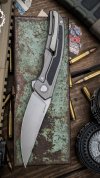Lenny
Gold Member
- Joined
- Oct 15, 1998
- Messages
- 2,496
I just don't get it.
Unless it's an integral handle, isn't it just as easy for the maker to mill the lock bar relief cutout
on the inside of the lock bar as on the outside? Clearly it makes for a cleaner
looking knife. But why do so many makers, including high end ones, mill out the
relief cutout on the outside? What am I missing here?
Unless it's an integral handle, isn't it just as easy for the maker to mill the lock bar relief cutout
on the inside of the lock bar as on the outside? Clearly it makes for a cleaner
looking knife. But why do so many makers, including high end ones, mill out the
relief cutout on the outside? What am I missing here?





